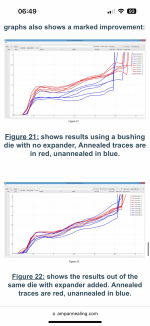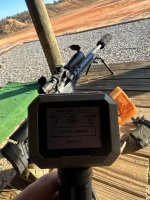So at this point, are we discussing whether more consistent seating force results in better groups/lower velocity SD/ES? Have we established that annealing does in fact produce more consistent seating force numbers? It seems like we have but it's hard to tell. If we have decided that annealing gives more consistent seating force numbers, the only question left is " does that matter?"
Consistent hardness gives consistent seating force. That's pretty easy to show. Especially on virgin brass with the factory anneal. Once you move to fired brass, then things get a bit more "complicated." Meaning, you need to define "consistent." Is consistent just that all your rounds are very close to one another? Or is consistent they are also very similar to past firings?
For example, virgin annealed takes 50lbs of seating force and all are very close. Once fired but not annealed takes 60lbs and all are very close.
Some would consider "consistent" to mean they want their second firing to also be close to 50lbs. Others would consider "consistent" to mean they don't care the exact seating force, just that they are all close....so 60lbs is fine.
The above is fairly easy to figure out which you prefer or need. You'll have to test to see if any or all of the above matters enough for you personally.
The "does it matter" is much, much more complicated. That will depend on your level of precision possible and required. For example, you'll find it extremely hard to see small differences off a bipod/rear bag that an F class shooter with a Neo and eared bag will see. (which is always something to keep in mind when you see people on YouTube claiming they can shoot the difference is primer seating depth or small variations in seating force.......when they are using an atlas bipod and a squeeze bag. Highly, highly unlikely).
For most people on this forum (assuming they are shooting tactical/practical 1-2moa or larger targets)......will have a hard time finding a difference in small variations in seating force.
Specifically speaking about the AMP Press, since it gives the most detail of the common force gauge presses......it's more valuable as a comparator tool. I.E. when you see something in the graph that never usually happens or is largely against the norm, you can identify and test if that matters. If it does, you make a note that when you see that type of graph, it's a culled round.
With everyone's loading methods being different in some way or form, it's going to be extremely hard for anyone to say "when you see XYZ on your seating force, that's good/bad."
Which is why you see these circular conversations. You can only compare ammo loaded the exact same way. Anything else is not going to be reliable data.



